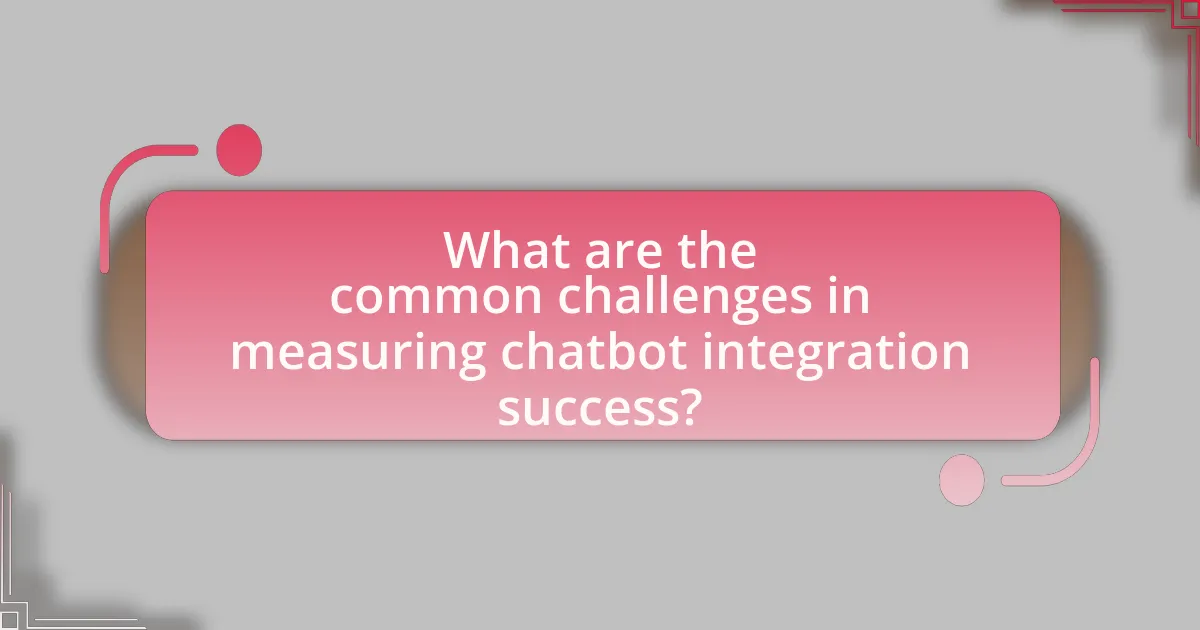The article focuses on measuring the success of chatbot integrations, emphasizing the importance of key performance indicators (KPIs) such as user engagement, resolution rates, and customer satisfaction scores. It outlines essential metrics for evaluating chatbot performance, discusses the significance of setting clear goals aligned with business objectives, and highlights common challenges in data collection and interpretation. Additionally, the article provides best practices for continuous improvement and effective measurement strategies, ensuring organizations can optimize their chatbot functionalities and enhance user experiences.

How can we define the success of chatbot integrations?
The success of chatbot integrations can be defined by evaluating key performance indicators (KPIs) such as user engagement, resolution rates, and customer satisfaction scores. User engagement metrics, including the number of interactions and session duration, indicate how effectively the chatbot captures user interest. Resolution rates measure the percentage of inquiries successfully handled by the chatbot without human intervention, reflecting its efficiency. Customer satisfaction scores, often gathered through post-interaction surveys, provide direct feedback on user experience. Research shows that organizations implementing chatbots can achieve a 30% increase in customer satisfaction and a 25% reduction in operational costs, validating the importance of these metrics in assessing integration success.
What metrics are essential for measuring chatbot success?
The essential metrics for measuring chatbot success include user engagement, resolution rate, customer satisfaction score, and retention rate. User engagement quantifies how often users interact with the chatbot, indicating its effectiveness in capturing attention. Resolution rate measures the percentage of inquiries successfully resolved by the chatbot, reflecting its capability to address user needs. Customer satisfaction score, often gathered through post-interaction surveys, provides insight into user perceptions of the chatbot’s performance. Retention rate assesses how many users return to interact with the chatbot over time, indicating its long-term value. These metrics collectively offer a comprehensive view of a chatbot’s effectiveness and user experience.
How do user engagement metrics reflect chatbot performance?
User engagement metrics directly reflect chatbot performance by quantifying user interactions and satisfaction levels. Metrics such as conversation length, response time, and user retention rates indicate how effectively a chatbot engages users. For instance, a high conversation length suggests that users find the chatbot’s responses valuable, while quick response times correlate with user satisfaction. Additionally, a retention rate above 60% typically signifies that users are returning to interact with the chatbot, indicating successful engagement. These metrics provide concrete evidence of a chatbot’s ability to meet user needs and enhance overall user experience.
What role does customer satisfaction play in evaluating chatbot success?
Customer satisfaction is a critical metric in evaluating chatbot success, as it directly reflects the effectiveness of the chatbot in meeting user needs. High customer satisfaction indicates that the chatbot is providing accurate responses, resolving issues efficiently, and enhancing the overall user experience. Research shows that 70% of customers prefer chatbots for quick answers to simple questions, highlighting the importance of satisfaction in determining a chatbot’s performance. Additionally, satisfied customers are more likely to engage with the chatbot again, leading to increased usage and improved business outcomes. Therefore, measuring customer satisfaction through surveys and feedback is essential for assessing and optimizing chatbot effectiveness.
Why is it important to set clear goals for chatbot integrations?
Setting clear goals for chatbot integrations is crucial because it provides a focused direction for development and evaluation. Clear goals enable organizations to define specific outcomes they want to achieve, such as improving customer satisfaction or increasing operational efficiency. For instance, a study by Gartner indicates that organizations with well-defined objectives for their chatbot implementations see a 30% higher success rate in meeting user needs compared to those without clear goals. This alignment ensures that resources are effectively utilized and that the chatbot’s performance can be accurately measured against established benchmarks.
What types of goals should businesses consider for their chatbots?
Businesses should consider goals such as improving customer service, increasing sales, enhancing user engagement, and reducing operational costs for their chatbots. Improving customer service can be measured by metrics like response time and customer satisfaction scores, which indicate how effectively the chatbot addresses inquiries. Increasing sales can be tracked through conversion rates from chatbot interactions, demonstrating the chatbot’s role in driving revenue. Enhancing user engagement can be assessed by monitoring user interaction rates and session durations, reflecting the chatbot’s ability to keep users interested. Reducing operational costs can be evaluated by analyzing the decrease in human agent workload and associated expenses, showcasing the chatbot’s efficiency in handling routine tasks. These goals align with the overall objective of measuring the success of chatbot integrations in a business context.
How can aligning chatbot goals with business objectives enhance success measurement?
Aligning chatbot goals with business objectives enhances success measurement by ensuring that the chatbot’s performance metrics directly reflect the organization’s strategic aims. When a chatbot is designed to meet specific business objectives, such as increasing customer satisfaction or reducing response times, its effectiveness can be quantitatively assessed against these predefined goals. For instance, if a business objective is to improve customer engagement by 20%, the chatbot’s success can be measured by tracking engagement metrics, such as the number of interactions or user feedback scores. This alignment allows for clear accountability and facilitates data-driven decision-making, as organizations can analyze whether the chatbot contributes to achieving broader business outcomes.

What are the common challenges in measuring chatbot integration success?
Common challenges in measuring chatbot integration success include defining clear metrics, data collection issues, and user engagement variability. Defining clear metrics is crucial because without specific goals, such as response time or user satisfaction, it becomes difficult to assess performance accurately. Data collection issues arise from integrating various systems, which can lead to incomplete or inconsistent data, making it hard to analyze chatbot effectiveness. User engagement variability complicates measurement as different users may interact with the chatbot in diverse ways, leading to inconsistent results that can skew success evaluations. These challenges highlight the complexity of accurately measuring the success of chatbot integrations.
How can data quality impact the measurement of chatbot success?
Data quality significantly impacts the measurement of chatbot success by influencing the accuracy and reliability of performance metrics. High-quality data ensures that user interactions are correctly captured and analyzed, leading to precise insights into user satisfaction, engagement rates, and issue resolution effectiveness. For instance, a study by the International Journal of Human-Computer Interaction found that chatbots trained on high-quality datasets achieved a 30% higher user satisfaction rate compared to those trained on poor-quality data. This correlation demonstrates that data quality directly affects the ability to measure and interpret chatbot performance accurately.
What strategies can be employed to ensure high-quality data collection?
To ensure high-quality data collection, organizations should implement standardized data collection protocols, utilize automated data validation tools, and conduct regular training for data collectors. Standardized protocols minimize variability and enhance consistency in data gathering, which is crucial for accurate analysis. Automated validation tools can identify errors or inconsistencies in real-time, ensuring that only reliable data is recorded. Regular training for data collectors equips them with the necessary skills and knowledge to adhere to best practices, further improving data quality. These strategies collectively contribute to the integrity and reliability of the data collected, which is essential for measuring the success of chatbot integrations effectively.
How does data privacy affect the measurement process?
Data privacy significantly impacts the measurement process by limiting the types of data that can be collected and analyzed. Regulations such as the General Data Protection Regulation (GDPR) impose strict guidelines on data collection, requiring explicit consent from users, which can reduce the volume of available data for measuring chatbot performance. For instance, a study by the International Association of Privacy Professionals (IAPP) found that 60% of organizations reported challenges in data collection due to privacy regulations, directly affecting their ability to assess user interactions and satisfaction with chatbots. Consequently, organizations must adapt their measurement strategies to comply with privacy laws while still obtaining meaningful insights, often leading to a reliance on aggregated or anonymized data, which may not provide the granularity needed for effective evaluation.
Why might businesses struggle with interpreting chatbot performance data?
Businesses might struggle with interpreting chatbot performance data due to the complexity of metrics and the lack of standardized benchmarks. The variety of performance indicators, such as user engagement, resolution rates, and customer satisfaction, can overwhelm businesses, making it difficult to identify which metrics are most relevant to their goals. Additionally, the absence of industry-wide standards means that businesses may not have a clear frame of reference for evaluating their chatbot’s effectiveness. This complexity is compounded by the potential for data misinterpretation, as businesses may draw incorrect conclusions from the data without proper analytical tools or expertise.
What tools can assist in analyzing chatbot performance effectively?
Tools that can assist in analyzing chatbot performance effectively include Google Analytics, Chatbase, and Botanalytics. Google Analytics provides insights into user interactions and engagement metrics, allowing for tracking of user behavior and conversion rates. Chatbase offers advanced analytics specifically designed for chatbots, enabling users to analyze conversation flows and identify areas for improvement. Botanalytics focuses on user engagement metrics and provides visualizations to help understand user interactions with the chatbot. These tools collectively enhance the ability to measure and optimize chatbot performance through data-driven insights.
How can businesses overcome biases in performance evaluation?
Businesses can overcome biases in performance evaluation by implementing structured evaluation criteria and utilizing data-driven assessment tools. Structured criteria ensure that all employees are evaluated based on the same standards, reducing subjectivity. Data-driven tools, such as performance analytics software, provide objective metrics that can highlight employee contributions without the influence of personal biases. Research indicates that organizations using standardized evaluation processes see a 25% reduction in bias-related discrepancies in performance ratings, as evidenced by a study published in the Journal of Applied Psychology.

What best practices should be followed for measuring chatbot integration success?
To measure chatbot integration success effectively, organizations should focus on key performance indicators (KPIs) such as user engagement, resolution rates, and customer satisfaction scores. User engagement can be assessed through metrics like the number of interactions per session and the frequency of return users, indicating how well the chatbot retains user interest. Resolution rates reflect the chatbot’s ability to address user inquiries without human intervention, which is crucial for evaluating efficiency. Customer satisfaction scores, often gathered through post-interaction surveys, provide direct feedback on user experience and effectiveness. According to a study by Gartner, organizations that implement these KPIs can improve chatbot performance by up to 30%, demonstrating the importance of structured measurement practices in achieving successful chatbot integration.
How can continuous improvement be integrated into chatbot success measurement?
Continuous improvement can be integrated into chatbot success measurement by establishing a feedback loop that incorporates user interactions, performance metrics, and iterative updates. This approach allows organizations to analyze user satisfaction through metrics such as Net Promoter Score (NPS) and Customer Satisfaction Score (CSAT), which provide quantitative data on user experience. Additionally, tracking key performance indicators (KPIs) like response time, resolution rate, and engagement levels enables teams to identify areas for enhancement. By regularly reviewing this data and implementing changes based on insights, organizations can ensure that the chatbot evolves to meet user needs effectively, thereby improving overall success.
What feedback loops are essential for refining chatbot performance?
Essential feedback loops for refining chatbot performance include user interaction analysis, continuous training based on user feedback, and performance metrics evaluation. User interaction analysis involves monitoring conversations to identify common issues and areas for improvement, which helps in understanding user needs. Continuous training based on user feedback ensures that the chatbot evolves by incorporating real-time insights from users, enhancing its ability to respond accurately. Performance metrics evaluation, such as tracking response times and user satisfaction scores, provides quantifiable data that informs necessary adjustments. These feedback loops collectively contribute to a more effective and responsive chatbot, ultimately improving user experience and satisfaction.
How often should chatbot performance be reviewed and adjusted?
Chatbot performance should be reviewed and adjusted at least quarterly. Regular reviews allow organizations to identify areas for improvement, adapt to user feedback, and enhance overall effectiveness. Research indicates that continuous monitoring and adjustment can lead to a 20-30% increase in user satisfaction and engagement, demonstrating the importance of timely evaluations in optimizing chatbot performance.
What are the key takeaways for businesses looking to measure chatbot success effectively?
To measure chatbot success effectively, businesses should focus on key performance indicators (KPIs) such as user engagement, resolution rates, and customer satisfaction scores. User engagement metrics, including the number of interactions and session duration, provide insights into how actively users are interacting with the chatbot. Resolution rates indicate the percentage of inquiries successfully handled by the chatbot without human intervention, which is crucial for assessing efficiency. Customer satisfaction scores, often gathered through post-interaction surveys, reflect users’ perceptions of the chatbot’s performance. According to a study by Gartner, organizations that measure these KPIs can improve their chatbot effectiveness by up to 30%, demonstrating the importance of a structured approach to evaluation.
What common pitfalls should be avoided in the measurement process?
Common pitfalls to avoid in the measurement process of chatbot integrations include failing to define clear objectives, neglecting to use relevant metrics, and not considering user feedback. Defining clear objectives ensures that the measurement process aligns with desired outcomes, while relevant metrics provide quantifiable data to assess performance. Additionally, incorporating user feedback is crucial, as it offers insights into user experience and satisfaction, which are essential for evaluating success. Research indicates that organizations that set specific goals and utilize comprehensive metrics are 30% more likely to achieve successful outcomes in technology integrations.
How can businesses leverage insights from chatbot data for future integrations?
Businesses can leverage insights from chatbot data for future integrations by analyzing user interactions to identify trends and preferences. This analysis allows companies to tailor their services and improve customer experiences based on real-time feedback. For instance, data on frequently asked questions can inform the development of new features or services that address common customer needs. Additionally, understanding user sentiment through chatbot conversations can guide businesses in refining their communication strategies and enhancing overall engagement. By utilizing analytics tools, businesses can track performance metrics such as response times and resolution rates, which can inform future integration decisions and optimize operational efficiency.










